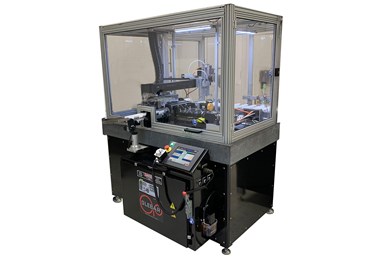Glebar PG-9DHD Form Grinder Reduces Green Ceramic Scrap Rate
Glebar’s PG-9DHD Centerless Form Grinder specializes in grinding pre-sintered ceramic shafts without chipping or breaking.
Share





Glebar’s fully automated PG-9DHD Centerless Form Grinder specializes in brittle pre-sintered (“green”) ceramics that require manufacturers to use precise and delicate processes to ensure part structural integrity. The company developed this grinder to solve problems for a manufacturer whose legacy equipment was breaking ceramic shafts and increasing scrap rates. Glebar was determined to find a solution that integrated with the manufacturer’s existing isostatic press, and that could accurately handle and grind the shafts without any chipping or breaking.
The PG-9DHD – equipped with a six-axis robot, inspection camera station, cleated conveyor and gantry – resulted from this effort. The six-axis robot sensed and transferred six ceramic shafts from the press onto the cleated conveyor. The shafts then passed through a camera station to ensure they were defect-free. Lastly, the gantry fed and removed two shafts from the grinder, reducing scrap and maximizing productivity.
The PG-9DHD removed 0.040” of stock material, 0.020” per side, while maintaining a tolerance of +/- 0.001”. By grinding two shafts every six seconds, the grinder was able to keep up with the ceramic press.
For operator safety and to achieve CE Certification, this PG-9DHD featured an enclosed grinding area and robot station.
Glebar says its machines can grind most hard-to-turn materials such as carbon fiber, fiberglass (including G10), Teflon, Santoprene and polypropylene.
Related Content
-
CNC Machine Shop Honored for Automation, Machine Monitoring
From cobots to machine monitoring, this Top Shop honoree shows that machining technology is about more than the machine tool.
-
How to Mitigate Chatter to Boost Machining Rates
There are usually better solutions to chatter than just reducing the feed rate. Through vibration analysis, the chatter problem can be solved, enabling much higher metal removal rates, better quality and longer tool life.
-
How to Determine the Currently Active Work Offset Number
Determining the currently active work offset number is practical when the program zero point is changing between workpieces in a production run.

























